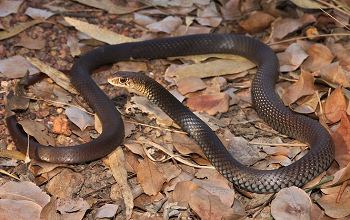Spatial and temporal patterns of snake occurrence in Darwin, Australia
Analysis of the spatiotemporal patterns of animal occurrence data can provide insight into the distribution, abundance, and dynamics of populations. This knowledge is essential for the development and implementation of effective conservation and management strategies for biodiversity, particularly in urban areas.
Human–snake interactions are a global issue that has significant impacts on both human and snake populations, with an estimated 2.5 million snake bites per year, leading to between 81,000 and 138,000 deaths annually. By identifying when and where snakes are most active in urban areas, conservationists and managers can take steps to mitigate conflicts between snakes and humans, such as by educating the public about snake behaviour and providing guidance on how to safely coexist with snakes. Additionally, understanding the seasonal patterns of snake occurrences can aid in the development of targeted conservation strategies, such as identifying key habitats for snakes and ensuring their protection throughout the year.
In the Northern Territory of Australia, professional snake catchers are employed by the territory government to provide information and advice to members of the public, as well as capture and remove snakes when necessary. With high quality data on snake occurrences being collected year-round, including species, times, and locations, this service provides an opportunity to observe the temporal and spatial patterns of snake encounters in anthropogenically modified environments
Progress
Our Darwin snake ecology project is the brainchild of ecologists with little to do in the NT during the first wave of COVID lockdowns. We had access to a seven-year snake catcher’s dataset, courtesy of Tom Parkin, that contains over 5000 high-quality location and date records of snakes in the Darwin region. This project has resulted in several publications and is ongoing. We won’t stop until we have fully exhausted the uses of this dataset! If you are interested in conducting an analysis on this dataset (e.g. for an Honours project), please get in touch!
Selected publications
von Takach, B., Lettoof, D. C., Parkin, T., de Laive, A., Allen, L., and Jolly, C. J. (2024) Analysing spatiotemporal patterns of snake occurrence in an Australian city to help manage human–wildlife conflict. Biodiversity and Conservation 33, 347–360. https://doi.org/10.1007/s10531-023-02752-2.
Lettoof, D. C., Parkin, T. P., Jolly, C. J., de Laive, A., and von Takach, B. (2023). Snake life history traits and their association with urban habitat use in a tropical city. Urban Ecosystems 26, 433–445. https://doi.org/10.1007/s11252-023-01327-x.
Parkin, T., Jolly, C. J., de Laive, A., and von Takach, B. (2020). Snakes on an urban plain: temporal patterns of snake activity and human-snake conflict in Darwin, Australia. Austral Ecology 46, 449–462. https://doi.org/10.1111/aec.12990.
